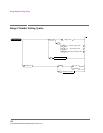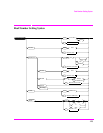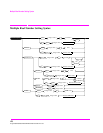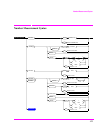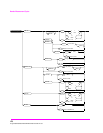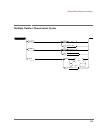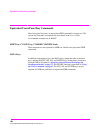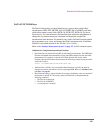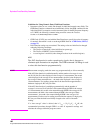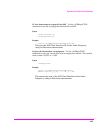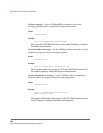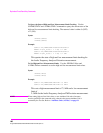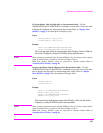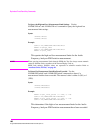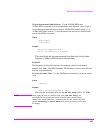
182
S:\agilent\8920\8920b\PRGGUIDE\BOOK\SECTIONS\efpkc.sec
Equivalent Front-Panel Key Commands
Guidelines for Using Numeric Entry Field Data Functions
• Increment values are set, scaled, and changed for individual numeric entry fields. The
GPIB Data Function commands must immediately follow the GPIB command for the
individual field. For example, to set the increment value for the RF Generator frequency
to 2.5 MHZ, the following command string would be sent to the Test Set:
OUTPUT 714;"RFG:FREQ:INCR 2.5 MHZ"
• GPIB Units (UNITs) are used with the Data Functions to specify the units-of-measure
for numeric data which is read or set through GPIB. Refer to “GPIB Units (UNITs)”
on page 78.
• Data Function settings are not retained. The setting values are initialized or changed
under the following conditions:
• The Test Set is turned off (values initialized on power up).
• The Test Set is PRESET (values initialized).
• A saved register is recalled (values changed to those in the recalled register).
AVG
The AVG data function is used to smooth noisy signals, that is, decrease or
eliminate rapid fluctuations in amplitude. The GPIB command :AVERage is used
to select this data function programmatically.
NOTE: Measurement averaging works the same way programmatically as it does manually
If the AVG data function is enabled manually and the number of averages is set to
ten (N=10), the first value displayed is the average of 1 measurement, the second
value displayed is the average of two measurements, the third value displayed is
the average of three measurements… the tenth value displayed is the average of
10 measurements. For readings greater than N the data function approximates a
hardware single-pole, RC low-pass filter.
If the AVG data function is enabled programmatically and the number of
averages is set to ten (N=10) the first value returned through GPIB is the average
of 1 measurement, the second value returned through GPIB is the average of two
measurements, the third value returned through GPIB is the average of three
measurements…the tenth value returned through GPIB is the average of 10
measurements. Each successive reading would mimic the output of a single-pole,
RC low-pass filter that had been initially charged to the value of the tenth
reading.
If a “true average” value is desired, that is V
avg
= (V
1
+V
2
+V
3
…V
N
)/N, the
recommended procedure through GPIB is to take N sequential readings and
calculate the average within the program context



